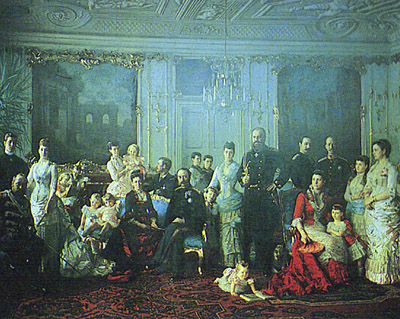| Fredensborg

| | Den danske konge Christian 9. blev kaldt Europas svigerfar, fordi han sønner og døtre blev gift ind i en række fremtrædende Europæiske fyrstehuse, som hyppigt tilbragte sommerferier på Fredensborg Slot.
(L. Tuxen: Kongefamilien på Fredensborg Slot. Malet 1883-86.) |
Det landliggeri og fritidsliv der udvikler sig i Nordsjælland i 1800-tallet er vel i pagt med den måde som kongefamilien i mange århundreder har anvendt landskabet på: til adspredelse og rekreation. Førhen var Nordsjælland kongens private legeplads, eller jagtområde, med indhegnede dyrehaver, egne veje og prangende slotte, hvor han kunne tage ophold. Først renæssanceslottene Kronborg og Frederiksborg Slot og sidst, midt imellem disse, Fredensborg Slot, der er opført omkring 1720.
I første del af 1800-tallet stod Fredensborg og forfaldt, men da Frederiksborg Slot brænder i 1859 begynder man at restaurere slottet og det er her kong Frederik 7.i 1862 modtager norske og svenske studenter og senere den svenske konge under skandinavismens banner i 1862.

Fredensborg Slot | 
Studenter ved Frederiksborg Slot |
Europas svigerfar
Fredensborg Slot bliver efterhånden, og især i Christian 9.s tid(1863-1906) kongefamiliens faste sommerresidens. Christian 9. kommer som den første af kongeslægtens sidegren Glücksburg på tronen i 1863 - året før Danmark mister Slesvig-Holsten og i areal skrumper til størrelse som et midteuropæisk fyrstendømme. Som en næsten symbolsk kompensation for sin nye småstatsstilling bliver kongefamilien leveringsdygtig i genetisk fornyelse til en række af de større europæiske kongehuse. Christian 8.s ældste søn, den senere Frederik 8. ægtede en svensk prinsesse Louise. Broderen Wilhelm blev valgt til græsk konge i 1863, søsteren Alexandra bliver gift med den engelske konge Edward VII og søsteren Dagmar med den senere czar Alexander III af Rusland.

Gruppeportræt fra Fredensborg | 
Tre vordende monarker | 
Zar Alexander | 
De kongelige børn | 
Familiehygge på Fredensborg |
Kejserlig forlovelse
Den omfangsrige kongefamilies faste mødested om sommeren blev Fredensborg Slot og her og i omegnen kunne man så risikere at støde på fremtrædende medlemmer af Europas kongehuse. På slottet og i den 85 ha. Store park var der god plads til at boltre sig, men man bevægede sig også frit udenfor i det naturskønne Nordsjælland, f.eks. til Julebæk på Nordkysten, hvor Dagmars forlovelse med den russiske tronfølger deklareredes i 1866. Den kommende russiske czar var børneven og spøgefugl, som allerede i 1881 måtte bestige tronen da hans far bliver myrdet på åben gade i Skt. Petersborg.

Kejserinde Dagmar | 
Forlovelsen i Julebæk |
|